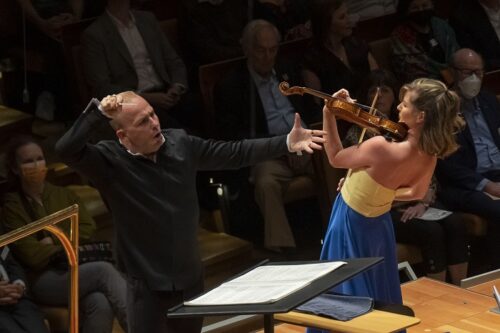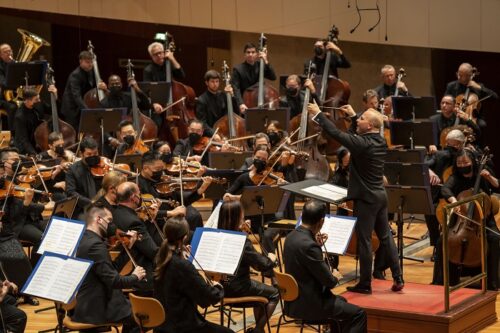
 Germany Musikfest Berlin 2022 [3] – Dvořák, Szymanowski, Price: Lisa Batiashvili (violin), Philadelphia Orchestra / Yannick Nézet-Séguin (conductor). Philharmonie Hall, Berlin, 1.9.2022, livestreamed on the Digital Concert Hall, 1.9.2022. (GT)
Germany Musikfest Berlin 2022 [3] – Dvořák, Szymanowski, Price: Lisa Batiashvili (violin), Philadelphia Orchestra / Yannick Nézet-Séguin (conductor). Philharmonie Hall, Berlin, 1.9.2022, livestreamed on the Digital Concert Hall, 1.9.2022. (GT)

Dvořák – Carnival Overture, Op.92
Szymanowski – Violin Concerto No.1, Op.35
Florence Price – Symphony No.1 in E minor (1932)
This programme follows that given at the Edinburgh International Festival last week which was well received, in particular, the symphony by the neglected American composer Florence Price. Nézet-Séguin has proselytised her symphonies and one hopes that other conductors will look at these works which have been shamefully ignored. One wonders how many other composer’s works await discovery as this symphony only came to light when her home was being demolished a few years ago.
As they did in Edinburgh, Nézet-Séguin opened with Dvořák’s Carnival Overture with superb playing especially in the strings and this dynamic conductor was directing it all as if his life depended on it! There were superb solos from the oboe and the flute principals, and we heard the graceful old folk theme in a passage of thrilling playing. This is rarely witnessed in the Carnival Overture which is often used as a ‘warming-up’ piece in concerts, but here was performed as a little symphonic work in its own right.
Attired in the colours of the Ukrainian flag, the Georgian violinist Lisa Batiashvili joined the orchestra for Szymanowski’s most popular violin concerto, his First. I recall that some ten years ago the Edinburgh International Festival programmed all of this Polish composer’s symphonies and concertos, yet few of his works are now heard in the concert hall.
The opening movement (Vivace assai) began brightly with the violin’s flowing rhapsodic idea against lively woodwind of kaleidoscopic beauty and the tubular bells brought more colour before a brisk theme on Batiashvili’s violin was played at an almost unbelievable fast tempo against chirpy woodwind and strings: here there was a beautiful, almost magical, sequence of nature with woodwind evoking birdcalls.
In the second movement (Subito vivace assai scherzando) the orchestra revealed its rich orchestral palate of harmonious colour in a passionate passage plunging to a stilled quietude and again there was bubbling woodwind and the dynamic violin of Batiashvili – playing at that almost breathless tempo – against the harmonies of the horn and the celeste. In the Andantino, there was a passage of delicious playing on the violin, the clarinet led to a rise in tempo with the horns and strings creating an ecstatic frenzy before settling down to a stillness; in the Allegretto, there was a wistful elegy on the solo violin and an upbeat idea from the orchestra; and in the Cadenza, Batiashvili displayed magical virtuosity leading to the grand orchestral culmination of this sensuous, dreamy masterpiece.

In Florence Price’s First Symphony, the Allegro ma non troppo began on the bassoon which was picked up by the strings for a striking theme with negro folk origins and taken up by the whole orchestra and underscored by glorious solos from the flute, oboe and clarinet. The principal horn introduced a gloriously romantic idea which was picked up by the flute and oboe and sounded even more alluring on the strings, it was clear that Nézet-Séguin believes in this composer and brought out the optimum virtuosity from his players – especially in great playing from the solo trumpet and the viola – leading to a stirring brass chorale.
In the Largo maestoso, the brass and clarinet introduced an American folksy idea, which when heard on the strings assumed an almost funereal idiom – yet became increasingly noble and graceful – as from negro folk spirituals in a section of tenderly elegant string playing building to another brass chorale and some tubular bells before concluding softly on the clarinet and cello.
The third movement (Juba Dance) was bright and colourful reflecting its irresistible jazz theme and was passed gloriously through the different groups of the orchestra yet was too brief, but still a sign of Price’s outstanding musicality and orchestral invention. The final movement (Allegro) opened on a bright tempo with an attractive folk theme and became increasingly energetic through the strings and wind sections bringing this fine symphony to a bright, uplifting ending.
As an encore to the enthusiastic audience, the orchestra played an arrangement of Florence Price’s ‘Adoration’ written for violin and piano in a fine orchestration which was succinct, yet colourful, in its passionate elegy before the music faded away. The last encore was Brahms’s Hungarian Dance No.21 which brought to a glittering close this wonderful exhibition of virtuosity by Philadelphia’s superbly gifted orchestra.
Gregor Tassie
